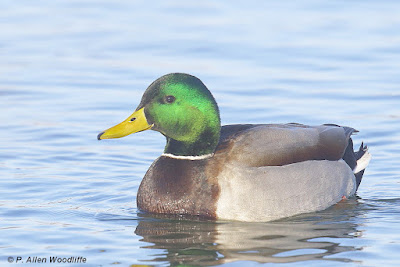Spring is teasing us a bit more lately. I've been out exploring a few places around Chatham-Kent, intermixed with things going on at the home front.
I often have stopped in at the warm water outlet along the Thames River right at the downstream side of Chatham. The cold weather had kept the opening in the ice quite small up until a few days ago. There has been a periodic change of water bird species, but not a lot of diversity this late in the season. One of the things I always look forward to in a cold winter is the great photo ops of even some of the more regular species.
Of course the ubiquitous Mallard is the most abundant....
...and the female Bufflehead continued for awhile.The numbers of Redhead has varied from 1-10.
Canada Geese are always somewhere around Chatham in winter, numbering in the several hundreds. There seems to be a constant movement of small groups from one location to another, and this provides some great photo ops.
Pied-billed Grebes are seldom very common in winter, but this one has persisted for weeks now.
With the recent warm spell and moderate rainfall, the Thames River drainage has resulted in a significant change. The once frozen over Thames River is completely open, with only a few scattered bits of ice clinging to the shoreline. Therefore waterbirds are widely scattered, and unless there is a prolonged cold spell (I hope not!!) that will put an end to photography at this location.
Hints of spring are showing up on the landscape. Killdeer have been reported in various locations over the past week or two. Red-winged Blackbirds are always a good sign, although given their general abundance over the next few weeks, will cease to be as much of a novelty as they are now. I saw more than a dozen along a shrubby corridor not far from one of the larger marshes in Chatham-Kent a few days ago.
American Goldfinches were frolicking in a nearby cedar hedge. Some of them were looking a bit more colourful than they were a few weeks ago. They are a far cry from their vivid breeding plumage, but any change is a nice hint of what is to come.A quick check of a Wood Duck box at St. Clair NWA resulted in seeing the resident Eastern Screech Owl show itself.
Horned Larks are fairly abundant, scattered far and wide along roadsides and fields.
I stopped in at the cemetery along Owen Road, where there are numerous cedars amongst the hardwoods. A Red-breasted Nuthatch, not an abundant species this winter, was there to greet me and posed politely for me.
I've only been to Rondeau on a couple of occasions lately. House Finches are fairly common in certain localities.
But the birds can be quite few and far between at this stage of the winter. On my most recent visit, yesterday, I wanted to take advantage of trekking along the west South Point Trail. Trails in general have been tricky lately, as the snow packed surfaces have turned into very uneven ice, making hiking a bit of a challenge. So with the recent mild weather and rain, a lot of the ice was gone, and the walk to the south end of the park was quite enjoyable, although the birds were few. The ice formations along the lake can be interesting and photogenic.
A bit of milder weather and the brisk winds that March is known for will spell the end of these types of features in fairly short order. There were a few open water spots barely visible with the binoculars, and a few rafts of waterfowl were scattered about, mostly scaup and Redhead, along with some Common Mergansers. But the bird highlight was to see at least 6 Bald Eagles perched on some of the ice mounds well out in the lake, while two more, both adults, soared overhead.
FYI, I am planning a short series featuring some changes in the birds of Chatham-Kent over the last century or more. I have an unpublished manuscript by A. A. Wood, entitled The Birds of Kent County, Ontario, which he prepared back in the 1940s. It was based on his research of notes and articles from birders over the previous 75 years. In reading some of the descriptions, I found it interesting to compare with today. So stay tuned!
If you want to subscribe, or unsubscribe, to Nature Nuggets, send an email to me at prairietramper@gmail.com




























































